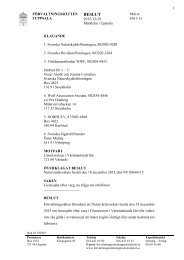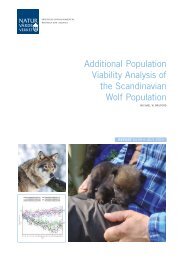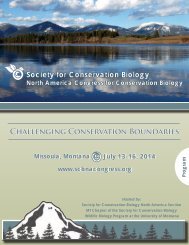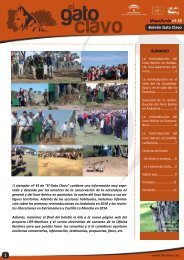1oC3Dbk
1oC3Dbk
1oC3Dbk
You also want an ePaper? Increase the reach of your titles
YUMPU automatically turns print PDFs into web optimized ePapers that Google loves.
Sea Snake Specialist Group<br />
The Sea Snake Specialist Group (SSSG) aims to promote the<br />
conservation of the world’s sea snakes by identifying,<br />
documenting and developing practical strategies for mitigating<br />
threats to their long-term survival and promoting, where<br />
necessary, the recovery of sustainable wild populations. We<br />
also work to advance knowledge and raise awareness of sea<br />
snakes and their habitats. Our focal species are the marine<br />
and coastal hydrophiines, and marine and freshwater<br />
homalopsids and acrochordids. Arne R. Rasmussen was<br />
appointed as Co-chair of the SSSG in mid-2013, replacing<br />
Vimoksalehi Lukoshek, who stepped down from this role in<br />
early 2013. Our group continues to expand, now with 35<br />
members in 20 countries.<br />
A major focus of 2013 was the severe decline of sea<br />
snakes on the Timor Sea reefs of Northwestern Australia. Nine<br />
sea snake species were previously resident at the Ashmore<br />
Reef Marine Reserve, with high population densities in coral,<br />
sea grass and lagoon habitats. However, following unexplained<br />
declines over the last ~15 years, all of these species have now<br />
disappeared. The Critically Endangered and endemic shortnosed<br />
and leaf-scaled sea snakes, Aipysurus apraefrontalis<br />
and A. foliosquama, were previously known only from Ashmore<br />
and neighbouring Hibernia Reef, but have not been sighted at<br />
either reef since 1998 despite intensive survey efforts.<br />
Members of the SSSG brought attention to this overlooked<br />
conservation crisis in 2013, via articles in international journals<br />
and the popular press. A three-week survey of the Timor Sea<br />
reefs in March 2013 further documented the decline of sea<br />
snakes in this region, and revealed a collapse of reproductive<br />
barriers (‘reverse speciation’) between A. laevis and<br />
Endangered A. fuscus at tiny Hibernia Reef. Declines in sea<br />
snake abundance over that last nine years in New Caledonia<br />
were also documented and publicized by SSSG members in<br />
Kate Sanders (left) and Arne Rasmussen (right) examining an Olive Sea<br />
Snake (Aipysurus laevis) in the Timor Sea.<br />
2013. Continued monitoring of these threatened sea snake<br />
populations, and understanding the causal factors underlying<br />
their declines, are key priorities for the SSSG.<br />
Kate L. Sanders and Arne R. Rasmussen<br />
Co-chairs, Sea Snake Specialist Group<br />
Seagrass Specialist Group<br />
The 72 species of seagrasses worldwide were assessed and<br />
listed on The IUCN Red List in 2011. The Seagrass Specialist<br />
Group had a preliminary meeting at the International Seagrass<br />
Biology Workshop in Buzios, Brazil, 2012. Scientists from<br />
around the world reported on some encouraging efforts to<br />
restore and conserve seagrasses, along with a growing<br />
recognition of the importance of seagrass habitat to the<br />
ecology of the coastal oceans. Seagrasses are food for<br />
manatee and dugongs as well as sea turtles, habitat for<br />
numerous organisms including sea horses, and nursery areas<br />
for temperate and tropical fishes. The next specialist group<br />
meeting will be held on Hainan Island, China in 2014.<br />
Halophila beccarii is a small oval-bladed seagrass which is<br />
listed as Vulnerable on The IUCN Red List. This delicate<br />
species has suffered extensive destruction in Southeast Asia as<br />
a result of mangrove deforestation and creation of shrimp<br />
aquaculture ponds. Working in southern China with the Guangxi<br />
Mangrove Research Center, we have initiated a project to restore<br />
H. beccarii to newly created mangrove reserves. Additionally,<br />
we are growing this species in culture to assess the growth<br />
patterns and determine expansion and turnover rates.<br />
The species status of the genus Halophila in the Pacific is<br />
under investigation through genetic analysis and barcoding, to<br />
determine the degree of genetic similarity between numerous<br />
species. A southwest Australian research team is using genetic<br />
analysis to examine the validity of species identifications that<br />
have been based on morphological characteristics. The<br />
analysis will help to create a better assessment of these<br />
species found throughout the Indo-Pacific. Investigations of<br />
the conservation status and genetics of Z. chilensis are<br />
underway by a group based in southeast Australia to assess<br />
this Endangered species. Zostera chilensis is one of the most<br />
threatened seagrasses, and little is known about the species.<br />
Growing on the Pacific coast of Chile, it has been documented<br />
for many years but the extent and genetic characteristics of<br />
this species needs further study.<br />
Manatee eating Syringodium filiforme in Belize. © Hoslo Jiwa<br />
Specialist Groups, Task Forces and Red List Authorities<br />
79






